19 Jan 2020
This is an ongoing series of posts on ELF Binary Relocations and Thread
Local Storage. This article covers only Thread Local Storage and assumes
the reader has had a primer in ELF Relocations, if not please start with
my previous article *ELF Binaries and Relocation Entries.
This is the second part in an illustrated 3 part series covering:
In the last article we covered ELF Binary internals and how relocation entries
are used to during link time to allow our programs to access symbols
(variables). However, what if we want a different variable instance for each
thread? This is where thread local storage (TLS) comes in.
In this article we will discuss how TLS works. Our outline:
As before, the examples in this article can be found in my tls-examples
project. Please check it out.
Thread Local Storage
Did you know that in C you can prefix variables with __thread to create
thread local variables?
Example
A thread local variable is a variable that will have a unique instance per thread.
Each time a new thread is created, the space required to store the thread local
variables is allocated.
TLS variables are stored in dynamic TLS sections.
TLS Sections
In the previous article we saw how variables were stored in the .data and
.bss sections. These are initialized once per program or library.
When we get to binaries that use TLS we will additionally have .tdata and
.tbss sections.
.tdata - static and non static initialized thread local variables.tbss - static and non static non-initialized thread local variables
These exist in a special TLS segment which
is loaded per thread. In the next article we will discuss more about how this
loading works.
TLS Data Structures
As we recall, to access data in .data and .bss sections simple code
sequences with relocation entries are used. These sequences set and add
registers to build pointers to our data. For example, the below sequence uses 2
relocations to compose a .bss section address into register r11.
Addr. Machine Code Assembly Relocations
0000000c <get_x_addr>:
c: 19 60 [00 00] l.movhi r11,[0] # c R_OR1K_AHI16 .bss
10: 44 00 48 00 l.jr r9
14: 9d 6b [00 00] l.addi r11,r11,[0] # 14 R_OR1K_LO_16_IN_INSN .bss
With TLS the code sequences to access our data will also build pointers to our
data, but they need to traverse the TLS data structures.
As the code sequence is read only and will be the same for each thread another
level of indirection is needed, this is provided by the Thread Pointer (TP).
The Thread Pointer points into a data structure that allows us to locate TLS
data sections. The TLS data structure includes:
- Thread Control Block (TCB)
- Dynamic Thread Vector (DTV)
- TLS Data Sections
These are illustrated as below:
dtv[] [ dtv[0], dtv[1], dtv[2], .... ]
counter ^ | \
----/ / \________
/ V V
/------TCB-------\/----TLS[1]----\ /----TLS[2]----\
| pthread tcbhead | tbss tdata | | tbss tdata |
\----------------/\--------------/ \--------------/
^
|
TP-----/
Thread Pointer (TP)
The TP is unique to each thread. It provides the starting point to the TLS data
structure.
- The TP points to the Thread Control Block
- On OpenRISC the TP is stored in
r10
- On x86_64 the TP is stored in
$fs
- This is the
*tls pointer passed to the
clone() system call when
using CLONE_SETTLS.
Thread Control Block (TCB)
The TCB is the head of the TLS data structure. The TCB consists of:
pthread - the pthread
struct for the current thread, contains tid etc. Located by TP - TCB size - Pthread sizetcbhead - the tcbhead_t struct, machine dependent, contains pointer to DTV. Located by TP - TCB size.
For OpenRISC tcbhead_t is defined in
sysdeps/or1k/nptl/tls.h as:
typedef struct {
dtv_t *dtv;
} tcbhead_t
dtv - is a pointer to the dtv array, points to entry dtv[1]
For x86_64 the tcbhead_t is defined in
sysdeps/x86_64/nptl/tls.h
as:
typedef struct
{
void *tcb; /* Pointer to the TCB. Not necessarily the
thread descriptor used by libpthread. */
dtv_t *dtv;
void *self; /* Pointer to the thread descriptor. */
int multiple_threads;
int gscope_flag;
uintptr_t sysinfo;
uintptr_t stack_guard;
uintptr_t pointer_guard;
unsigned long int vgetcpu_cache[2];
/* Bit 0: X86_FEATURE_1_IBT.
Bit 1: X86_FEATURE_1_SHSTK.
*/
unsigned int feature_1;
int __glibc_unused1;
/* Reservation of some values for the TM ABI. */
void *__private_tm[4];
/* GCC split stack support. */
void *__private_ss;
/* The lowest address of shadow stack, */
unsigned long long int ssp_base;
/* Must be kept even if it is no longer used by glibc since programs,
like AddressSanitizer, depend on the size of tcbhead_t. */
__128bits __glibc_unused2[8][4] __attribute__ ((aligned (32)));
void *__padding[8];
} tcbhead_t;
The x86_64 implementation includes many more fields including:
gscope_flag - Global Scope lock flags used by the runtime linker, for OpenRISC this is stored in pthread.stack_guard - The stack
guard canary stored in
the thread local area. For OpenRISC a global stack guard is stored in .bss.pointer_guard - The pointer
guard stored in the
thread local area. For OpenRISC a global pointer guard is stored in .bss.
Dynamic Thread Vector (DTV)
The DTV is an array of pointers to each TLS data section. The first entry in
the DTV array contains the generation counter. The generation counter is really
just the array size. The DTV can be dynamically resized as more TLS modules are loaded.
The dtv_t type is a union as defined below:
typedef struct {
void *val; // Aligned pointer to data/bss
void *to_free; // Unaligned pointer for free()
} dtv_pointer
typedef union {
int counter; // for entry 0
dtv_pointer pointer; // for all other entries
} dtv_t
Each dtv_t entry can be either a counter or a pointer. By convention the
first entry, dtv[0] is a counter and the rest are pointers.
Thread Local Storage (TLS)
The initial set of TLS data sections is allocated contiguous with the TCB. Additional TLS
data blocks will be allocated dynamically. There will be one entry for each
loaded module, the first module being the current program. For dynamic
libraries it is lazily initialized per thread.
Local (or TLS[1])
tbss - the .tbss section for the current thread from the current
processes ELF binary.tdata - the .tdata section for the current thread from the current
processes ELF binary.
TLS[2]
tbss - the .tbss section for variables defined in the first shared library loaded by the current processtdata - the .tdata section for variables defined in the first shared library loaded by the current process
The __tls_get_addr() function
The __tls_get_addr() function can be used at any time to traverse the TLS data
structure and return a variable’s address. The function is given a pointer to
an architecture specific argument tls_index.
- The argument contains 2 pieces of data:
- The module index -
0 for the current process, 1 for the first loaded shared
library etc.
- The data offset - the offset of the variable in the
TLS data section
- Internally
__tls_get_addr uses TP to located the TLS data structure
- The function returns the address of the variable we want to access
For static builds the implementation is architecture dependant and defined in
OpenRISC
sysdeps/or1k/libc-tls.c
as:
__tls_get_addr (tls_index *ti)
{
dtv_t *dtv = THREAD_DTV ();
return (char *) dtv[1].pointer.val + ti->ti_offset;
}
Note for for static builds the module index can be hard coded to 1 as there
will always be only one module.
For dynamically linked programs the implementation is defined as part of the
runtime dynamic linker in
elf/dl-tls.c
as:
void *
__tls_get_addr (GET_ADDR_ARGS)
{
dtv_t *dtv = THREAD_DTV ();
if (__glibc_unlikely (dtv[0].counter != GL(dl_tls_generation)))
return update_get_addr (GET_ADDR_PARAM);
void *p = dtv[GET_ADDR_MODULE].pointer.val;
if (__glibc_unlikely (p == TLS_DTV_UNALLOCATED))
return tls_get_addr_tail (GET_ADDR_PARAM, dtv, NULL);
return (char *) p + GET_ADDR_OFFSET;
}
Here several macros are used so it’s a bit hard to follow but there are:
THREAD_DTV - uses TP to get the pointer to the DTV array.GET_ADDR_ARGS - short for tls_index* tiGET_ADDR_PARAM - short for tiGET_ADDR_MODULE - short for ti->ti_moduleGET_ADDR_OFFSET - short for ti->ti_offset
TLS Access Models
As one can imagine, traversing the TLS data structures when accessing each variable
could be slow. For this reason there are different TLS access models that the
compiler can choose to minimize variable access overhead.
Global Dynamic
The Global Dynamic (GD), sometimes called General Dynamic, access model is the
slowest access model which will traverse the entire TLS data structure for each
variable access. It is used for accessing variables in dynamic shared
libraries.
Before Linking

Not counting relocations for the PLT and GOT entries; before linking the .text
contains 1 placeholder for a GOT offset. This GOT entry will contain the
arguments to __tls_get_addr.
After Linking
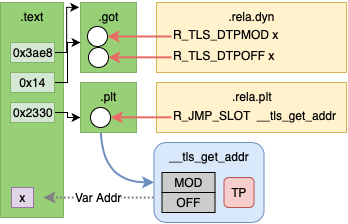
After linking there will be 2 relocation entries in the GOT to be resolved by
the dynamic linker. These are R_TLS_DTPMOD, the TLS module index, and
R_TLS_DTPOFF, the offset of the variable into the TLS module.
Example
File: tls-gd.c
extern __thread int x;
int* get_x_addr() {
return &x;
}
Code Sequence (OpenRISC)
tls-gd.o: file format elf32-or1k
Disassembly of section .text:
0000004c <get_x_addr>:
4c: 18 60 [00 00] l.movhi r3,[0] # 4c: R_OR1K_TLS_GD_HI16 x
50: 9c 21 ff f8 l.addi r1,r1,-8
54: a8 63 [00 00] l.ori r3,r3,[0] # 54: R_OR1K_TLS_GD_LO16 x
58: d4 01 80 00 l.sw 0(r1),r16
5c: d4 01 48 04 l.sw 4(r1),r9
60: 04 00 00 02 l.jal 68 <get_x_addr+0x1c>
64: 1a 00 [00 00] l.movhi r16,[0] # 64: R_OR1K_GOTPC_HI16 _GLOBAL_OFFSET_TABLE_-0x4
68: aa 10 [00 00] l.ori r16,r16,[0] # 68: R_OR1K_GOTPC_LO16 _GLOBAL_OFFSET_TABLE_
6c: e2 10 48 00 l.add r16,r16,r9
70: 04 00 [00 00] l.jal [0] # 70: R_OR1K_PLT26 __tls_get_addr
74: e0 63 80 00 l.add r3,r3,r16
78: 85 21 00 04 l.lwz r9,4(r1)
7c: 86 01 00 00 l.lwz r16,0(r1)
80: 44 00 48 00 l.jr r9
84: 9c 21 00 08 l.addi r1,r1,8
Code Sequence (x86_64)
tls-gd.o: file format elf64-x86-64
Disassembly of section .text:
0000000000000020 <get_x_addr>:
20: 48 83 ec 08 sub $0x8,%rsp
24: 66 48 8d 3d [00 00 00 00] lea [0](%rip),%rdi # 28 R_X86_64_TLSGD x-0x4
2c: 66 66 48 e8 [00 00 00 00] callq [0] # 30 R_X86_64_PLT32 __tls_get_addr-0x4
34: 48 83 c4 08 add $0x8,%rsp
38: c3 retq
Local Dynamic
The Local Dynamic (LD) access model is an optimization for Global Dynamic where
multiple variables may be accessed from the same TLS module. Instead of
traversing the TLS data structure for each variable, the TLS data section address
is loaded once by calling __tls_get_addr with an offset of 0. Next, variables
can be accessed with individual offsets.
Local Dynamic is not supported on OpenRISC yet.
Before Linking
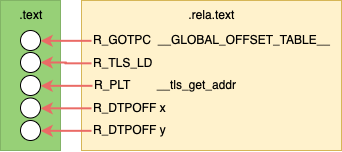
Not counting relocations for the PLT and GOT entries; before linking the .text
contains 1 placeholder for a GOT offset and 2 placeholders for the TLS offsets.
This GOT entry will contain the arguments to __tls_get_addr.
The TLD offsets will be the offsets to our variables in the TLD data section.
After Linking
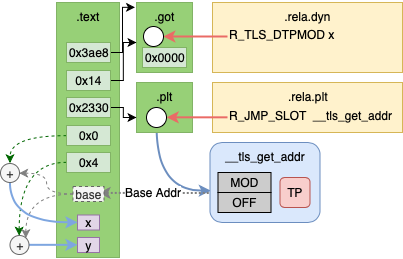
After linking there will be 1 relocation entry in the GOT to be resolved by
the dynamic linker. This is R_TLS_DTPMOD, the TLS module index, the offset
will be 0x0.
Example
File: tls-ld.c
static __thread int x;
static __thread int y;
int sum() {
return x + y;
}
Code Sequence (x86_64)
tls-ld.o: file format elf64-x86-64
Disassembly of section .text:
0000000000000030 <sum>:
30: 48 83 ec 08 sub $0x8,%rsp
34: 48 8d 3d [00 00 00 00] lea [0](%rip),%rdi # 37 R_X86_64_TLSLD x-0x4
3b: e8 [00 00 00 00] callq [0] # 3c R_X86_64_PLT32 __tls_get_addr-0x4
40: 8b 90 [00 00 00 00] mov [0](%rax),%edx # 42 R_X86_64_DTPOFF32 x
46: 03 90 [00 00 00 00] add [0](%rax),%edx # 48 R_X86_64_DTPOFF32 y
4c: 48 83 c4 08 add $0x8,%rsp
50: 89 d0 mov %edx,%eax
52: c3 retq
Initial Exec
The Initial Exec (IE) access model does not require traversing the TLS data
structure. It requires that the compiler knows that offset from the TP to the
variable can be computed during link time.
As Initial Exec does not require calling __tls_get_addr is is more efficient
compared the GD and LD access.
Before Linking

Text contains a placeholder for the got address of the offset. Not counting
relocation entry for the GOT; before linking the .text contains 1 placeholder
for a GOT offset. This GOT entry will contain the TP offset to the variable.
After Linking
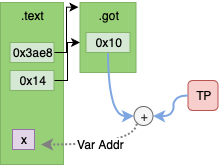
After linking there will be no remaining relocation entries. The .text section
contains the actual GOT offset and the GOT entry will contain the TP offset
to the variable.
Example
File: tls-ie.c
Initial exec C code will be the same as global dynamic, however IE access will
be chosen when static compiling.
extern __thread int x;
int* get_x_addr() {
return &x;
}
Code Sequence (OpenRISC)
00000038 <get_x_addr>:
38: 9c 21 ff fc l.addi r1,r1,-4
3c: 1a 20 [00 00] l.movhi r17,[0x0] # 3c: R_OR1K_TLS_IE_AHI16 x
40: d4 01 48 00 l.sw 0(r1),r9
44: 04 00 00 02 l.jal 4c <get_x_addr+0x14>
48: 1a 60 [00 00] l.movhi r19,[0x0] # 48: R_OR1K_GOTPC_HI16 _GLOBAL_OFFSET_TABLE_-0x4
4c: aa 73 [00 00] l.ori r19,r19,[0x0] # 4c: R_OR1K_GOTPC_LO16 _GLOBAL_OFFSET_TABLE_
50: e2 73 48 00 l.add r19,r19,r9
54: e2 31 98 00 l.add r17,r17,r19
58: 85 71 [00 00] l.lwz r11,[0](r17) # 58: R_OR1K_TLS_IE_LO16 x
5c: 85 21 00 00 l.lwz r9,0(r1)
60: e1 6b 50 00 l.add r11,r11,r10
64: 44 00 48 00 l.jr r9
68: 9c 21 00 04 l.addi r1,r1,4
Code Sequence (x86_64)
0000000000000010 <get_x_addr>:
10: 48 8b 05 [00 00 00 00] mov 0x0(%rip),%rax # 13: R_X86_64_GOTTPOFF x-0x4
17: 64 48 03 04 25 00 00 00 00 add %fs:0x0,%rax
20: c3 retq
Local Exec
The Local Exec (LD) access model does not require traversing the TLS data
structure or a GOT entry. It is chosen by the compiler when accessing file
local variables in the current program.
The Local Exec access model is the most efficient.
Before Linking

Before linking the .text section contains one relocation entry for a TP
offset.
After Linking
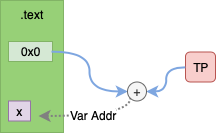
After linking the .text section contains the value of the TP offset.
Example
File: tls-le.c
In the Local Exec example the variable x is local, it is not extern.
static __thread int x;
int * get_x_addr() {
return &x;
}
Code Sequence (OpenRISC)
00000010 <get_x_addr>:
10: 19 60 [00 00] l.movhi r11,[0x0] # 10: R_OR1K_TLS_LE_AHI16 .LANCHOR0
14: e1 6b 50 00 l.add r11,r11,r10
18: 44 00 48 00 l.jr r9
1c: 9d 6b [00 00] l.addi r11,r11,[0] # 1c: R_OR1K_TLS_LE_LO16 .LANCHOR0
Code Sequence (x86_64)
0000000000000010 <get_x_addr>:
10: 64 48 8b 04 25 00 00 00 00 mov %fs:0x0,%rax
19: 48 05 [00 00 00 00] add $0x0,%rax # 1b: R_X86_64_TPOFF32 x
1f: c3 retq
Linker Relaxation
As some TLS access methods are more efficient than others we would like to
choose the best method for each variable access. However, we sometimes don’t know
where a variable will come from until link time.
On some architectures the linker will rewrite the TLS access code sequence to
change to a more efficient access model, this is called relaxation.
One type of relaxation performed by the linker is GD to IE relaxation. During compile
time GD relocation may be chosen for extern variables. However, during link time
the variable may be found in the same module i.e. not a shared object which would require
GD access. In this case the access model can be changed to IE.
That’s pretty cool.
The architecture I work on OpenRISC does not support any
of this yet, it requires changes to the compiler and linker. The compiler needs
to be updated to mark sections of the output .text that can be rewritten
(often with added NOP codes). The linker needs to be updated to know how to
identify the relaxation opportunity and perform it.
Summary
In this article we have covered how TLS variables are accessed per thread via
the TLS data structure. Also, we saw how different TLS access models provide
varying levels of efficiency.
In the next article we will look more into how this is implemented in GCC, the
linker and the GLIBC runtime dynamic linker.
Further Reading
29 Nov 2019
Recently I have been working on getting the OpenRISC glibc
port ready for upstreaming. Part of this work has been to run the glibc
testsuite and get the tests to pass. The glibc testsuite
has a comprehensive set of linker and runtime relocation tests.
In order to fix issues with tests I had to learn more than I did before about ELF Relocations
, Thread Local Storage and the binutils linker implementation in BFD. There is a lot of
documentation available, but it’s a bit hard to follow as it assumes certain
knowledge, for example have a look at the Solaris Linker and Libraries
section on relocations. In this article I will try to fill in those gaps.
This will be an illustrated 3 part series covering
All of the examples in this article can be found in my tls-examples
project. Please check it out.
On Linux, you can download it and make it with your favorite toolchain.
By default it will cross compile using an openrisc toolchain.
This can be overridden with the CROSS_COMPILE variable.
For example, to build for your current host.
$ git clone git@github.com:stffrdhrn/tls-examples.git
$ make CROSS_COMPILE=
gcc -fpic -c -o tls-gd-dynamic.o tls-gd.c -Wall -O2 -g
gcc -fpic -c -o nontls-dynamic.o nontls.c -Wall -O2 -g
...
objdump -dr x-static.o > x-static.S
objdump -dr xy-static.o > xy-static.S
Now we can get started.
ELF Segments and Sections
Before we can talk about relocations we need to talk a bit about what makes up
ELF binaries.
This is a prerequisite as relocations and TLS are part of ELF binaries. There
are a few basic ELF binary types:
- Objects (
.o) - produced by a compiler, contains a collection of sections, also call relocatable files.
- Program - an executable program, contains sections grouped into segments.
- Shared Objects (
.so) - a program library, contains sections grouped into segments.
- Core Files - core dump of program memory, these are also ELF binaries
Here we will discuss Object Files and Program Files.
An ELF Object
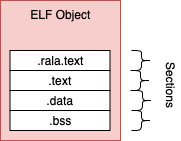
The compiler generates object files, these contain sections of binary data and
these are not executable.
The object file produced by gcc
generally contains .rela.text, .text, .data and .bss sections.
.rela.text - a list of relocations against the .text section.text - contains compiled program machine code.data - static and non static initialized variable values.bss - static and non static non-initialized variables
An ELF Program

ELF binaries are made of sections and segments.
A segment contains a group of sections and the segment defines how the data should
be loaded into memory for program execution.
Each segment is mapped to program memory by the kernel when a process is created. Program files contain
most of the same sections as objects but there are some differences.
.text - contains executable program code, there is no .rela.text section.got - the global offset table used to access variables, created during link time. May be populated during runtime.
Looking at ELF binaries (readelf)
The readelf tool can help inspect elf binaries.
Some examples:
Reading Sections of an Object File
Using the -S option we can read sections from an elf file.
As we can see below we have the .text, .rela.text, .bss and many other
sections.
$ readelf -S tls-le-static.o
There are 20 section headers, starting at offset 0x604:
Section Headers:
[Nr] Name Type Addr Off Size ES Flg Lk Inf Al
[ 0] NULL 00000000 000000 000000 00 0 0 0
[ 1] .text PROGBITS 00000000 000034 000020 00 AX 0 0 4
[ 2] .rela.text RELA 00000000 0003f8 000030 0c I 17 1 4
[ 3] .data PROGBITS 00000000 000054 000000 00 WA 0 0 1
[ 4] .bss NOBITS 00000000 000054 000000 00 WA 0 0 1
[ 5] .tbss NOBITS 00000000 000054 000004 00 WAT 0 0 4
[ 6] .debug_info PROGBITS 00000000 000054 000074 00 0 0 1
[ 7] .rela.debug_info RELA 00000000 000428 000084 0c I 17 6 4
[ 8] .debug_abbrev PROGBITS 00000000 0000c8 00007c 00 0 0 1
[ 9] .debug_aranges PROGBITS 00000000 000144 000020 00 0 0 1
[10] .rela.debug_arang RELA 00000000 0004ac 000018 0c I 17 9 4
[11] .debug_line PROGBITS 00000000 000164 000087 00 0 0 1
[12] .rela.debug_line RELA 00000000 0004c4 00006c 0c I 17 11 4
[13] .debug_str PROGBITS 00000000 0001eb 00007a 01 MS 0 0 1
[14] .comment PROGBITS 00000000 000265 00002b 01 MS 0 0 1
[15] .debug_frame PROGBITS 00000000 000290 000030 00 0 0 4
[16] .rela.debug_frame RELA 00000000 000530 000030 0c I 17 15 4
[17] .symtab SYMTAB 00000000 0002c0 000110 10 18 15 4
[18] .strtab STRTAB 00000000 0003d0 000025 00 0 0 1
[19] .shstrtab STRTAB 00000000 000560 0000a1 00 0 0 1
Reading Sections of a Program File
Using the -S option on a program file we can also read the sections. The file
type does not matter as long as it is an ELF we can read the sections.
As we can see below there is no longer a rela.text section, but we have others
including the .got section.
$ readelf -S tls-le-static
There are 31 section headers, starting at offset 0x32e8fc:
Section Headers:
[Nr] Name Type Addr Off Size ES Flg Lk Inf Al
[ 0] NULL 00000000 000000 000000 00 0 0 0
[ 1] .text PROGBITS 000020d4 0000d4 080304 00 AX 0 0 4
[ 2] __libc_freeres_fn PROGBITS 000823d8 0803d8 001118 00 AX 0 0 4
[ 3] .rodata PROGBITS 000834f0 0814f0 01544c 00 A 0 0 4
[ 4] __libc_subfreeres PROGBITS 0009893c 09693c 000024 00 A 0 0 4
[ 5] __libc_IO_vtables PROGBITS 00098960 096960 0002f4 00 A 0 0 4
[ 6] __libc_atexit PROGBITS 00098c54 096c54 000004 00 A 0 0 4
[ 7] .eh_frame PROGBITS 00098c58 096c58 0027a8 00 A 0 0 4
[ 8] .gcc_except_table PROGBITS 0009b400 099400 000089 00 A 0 0 1
[ 9] .note.ABI-tag NOTE 0009b48c 09948c 000020 00 A 0 0 4
[10] .tdata PROGBITS 0009dc28 099c28 000010 00 WAT 0 0 4
[11] .tbss NOBITS 0009dc38 099c38 000024 00 WAT 0 0 4
[12] .init_array INIT_ARRAY 0009dc38 099c38 000004 04 WA 0 0 4
[13] .fini_array FINI_ARRAY 0009dc3c 099c3c 000008 04 WA 0 0 4
[14] .data.rel.ro PROGBITS 0009dc44 099c44 0003bc 00 WA 0 0 4
[15] .data PROGBITS 0009e000 09a000 000de0 00 WA 0 0 4
[16] .got PROGBITS 0009ede0 09ade0 000064 04 WA 0 0 4
[17] .bss NOBITS 0009ee44 09ae44 000bec 00 WA 0 0 4
[18] __libc_freeres_pt NOBITS 0009fa30 09ae44 000014 00 WA 0 0 4
[19] .comment PROGBITS 00000000 09ae44 00002a 01 MS 0 0 1
[20] .debug_aranges PROGBITS 00000000 09ae6e 002300 00 0 0 1
[21] .debug_info PROGBITS 00000000 09d16e 0fd048 00 0 0 1
[22] .debug_abbrev PROGBITS 00000000 19a1b6 0270ca 00 0 0 1
[23] .debug_line PROGBITS 00000000 1c1280 0ce95c 00 0 0 1
[24] .debug_frame PROGBITS 00000000 28fbdc 0063bc 00 0 0 4
[25] .debug_str PROGBITS 00000000 295f98 011e35 01 MS 0 0 1
[26] .debug_loc PROGBITS 00000000 2a7dcd 06c437 00 0 0 1
[27] .debug_ranges PROGBITS 00000000 314204 00c900 00 0 0 1
[28] .symtab SYMTAB 00000000 320b04 0075d0 10 29 926 4
[29] .strtab STRTAB 00000000 3280d4 0066ca 00 0 0 1
[30] .shstrtab STRTAB 00000000 32e79e 00015c 00 0 0 1
Key to Flags:
W (write), A (alloc), X (execute), M (merge), S (strings), I (info),
L (link order), O (extra OS processing required), G (group), T (TLS),
C (compressed), x (unknown), o (OS specific), E (exclude),
p (processor specific)
Reading Segments from a Program File
Using the -l option on a program file we can read the segments.
Notice how segments map from file offsets to memory offsets and alignment.
The two different LOAD type segments are segregated by read only/execute and read/write.
Each section is also mapped to a segment here. As we can see .text is in the first LOAD` segment
which is executable as expected.
$ readelf -l tls-le-static
Elf file type is EXEC (Executable file)
Entry point 0x2104
There are 5 program headers, starting at offset 52
Program Headers:
Type Offset VirtAddr PhysAddr FileSiz MemSiz Flg Align
LOAD 0x000000 0x00002000 0x00002000 0x994ac 0x994ac R E 0x2000
LOAD 0x099c28 0x0009dc28 0x0009dc28 0x0121c 0x01e1c RW 0x2000
NOTE 0x09948c 0x0009b48c 0x0009b48c 0x00020 0x00020 R 0x4
TLS 0x099c28 0x0009dc28 0x0009dc28 0x00010 0x00034 R 0x4
GNU_RELRO 0x099c28 0x0009dc28 0x0009dc28 0x003d8 0x003d8 R 0x1
Section to Segment mapping:
Segment Sections...
00 .text __libc_freeres_fn .rodata __libc_subfreeres __libc_IO_vtables __libc_atexit .eh_frame .gcc_except_table .note.ABI-tag
01 .tdata .init_array .fini_array .data.rel.ro .data .got .bss __libc_freeres_ptrs
02 .note.ABI-tag
03 .tdata .tbss
04 .tdata .init_array .fini_array .data.rel.ro
Reading Segments from an Object File
Using the -l option with an object file does not work as we can see below.
readelf -l tls-le-static.o
There are no program headers in this file.
Relocation entries
As mentioned an object file by itself is not executable. The main reason is that
there are no program headers as we just saw. Another reason is that
the .text section still contains relocation entries (or placeholders) for the
addresses of variables located in the .data and .bss sections.
These placeholders will just be 0 in the machine code. So, if we tried to run
the machine code in an object file we would end up with Segmentation faults (SEGV).
A relocation entry is a placeholder that is added by the compiler or linker when
producing ELF binaries.
The relocation entries are to be filled in with addresses pointing to data.
Relocation entries can be made in code such as the .text section or in data
sections like the .got section. For example:
Resolving Relocations

The diagram above shows relocation entries as white circles.
Relocation entries may be filled or resolved at link-time or dynamically during execution.
Link time relocations
- Place holders are filled in when ELF object files are linked by the linker to create executables or libraries
- For example, relocation entries in
.text sections
Dynamic relocations
- Place holders is filled during runtime by the dynamic linker. i.e. Procedure Link Table
- For example, relocation entries added to
.got and .plt sections which link
to shared objects.
Note: Statically built binaries do not have any dynamic relocations and are not
loaded with the dynamic linker.
In general link time relocations are used to fill in relocation entries in code.
Dynamic relocations fill in relocation entries in data sections.
Listing Relocation Entries
A list of relocations in a ELF binary can printed using readelf with
the -r options.
Output of readelf -r tls-gd-dynamic.o
Relocation section '.rela.text' at offset 0x530 contains 10 entries:
Offset Info Type Sym.Value Sym. Name + Addend
00000000 00000f16 R_OR1K_TLS_GD_HI1 00000000 x + 0
00000008 00000f17 R_OR1K_TLS_GD_LO1 00000000 x + 0
00000020 0000100c R_OR1K_GOTPC_HI16 00000000 _GLOBAL_OFFSET_TABLE_ - 4
00000024 0000100d R_OR1K_GOTPC_LO16 00000000 _GLOBAL_OFFSET_TABLE_ + 0
0000002c 00000d0f R_OR1K_PLT26 00000000 __tls_get_addr + 0
...
The relocation entry list explains how to and where to apply the relocation entry.
It contains:
Offset - the location in the binary that needs to be updatedInfo - the encoded value containing the Type, Sym and Addend, which is
broken down to:
Type - the type of relocation (the formula for what is to be performed is defined in the
linker)Sym. Value - the address value (if known) of the symbol.Sym. Name - the name of the symbol (variable name) that this relocation needs to find
during link time.
Addend - a value that needs to be added to the derived symbol address.
This is used to with arrays (i.e. for a relocation referencing a[14] we would have Sym. Name a and an Addend of the data size of a times 14)
Example
File: nontls.c
In the example below we have a simple variable and a function to access it’s
address.
static int x;
int* get_x_addr() {
return &x;
}
Let’s see what happens when we compile this source.
The steps to compile and link can be found in the tls-examples project hosting
the source examples.
Before Linking
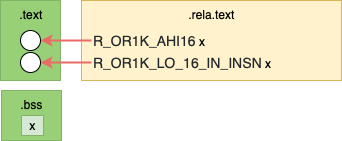
The diagram above shows relocations in the resulting object file as white circles.
In the actual output below we can see that access to the variable x is
referenced by a literal 0 in each instruction. These are highlighted with
square brackets [] below for clarity.
These empty parts of the .text section are relocation entries.
Addr. Machine Code Assembly Relocations
0000000c <get_x_addr>:
c: 19 60 [00 00] l.movhi r11,[0] # c R_OR1K_AHI16 .bss
10: 44 00 48 00 l.jr r9
14: 9d 6b [00 00] l.addi r11,r11,[0] # 14 R_OR1K_LO_16_IN_INSN .bss
The function get_x_addr will return the address of variable x.
We can look at the assembly instruction to understand how this is done. Some background
of the OpenRISC ABI.
- Registers are 32-bit.
- Function return values are placed in register
r11.
- To return from a function we jump to the address in the link register
r9.
- OpenRISC has a branch delay slot, meaning the address after a branch it executed
before the branch is taken.
Now, lets break down the assembly:
l.movhi - move the value [0] into high bits of register r11, clearing the lower bits.l.addi - add the value in register r11 to the value [0] and store the results in r11.l.jr - jump to the address in r9
This constructs a 32-bit value out of 2 16-bit values.
After Linking
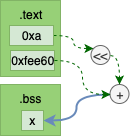
The diagram above shows the relocations have been replaced with actual values.
As we can see from the linker output the places in the machine code that had relocation place holders
are now replaced with values. For example 1a 20 00 00 has become 1a 20 00 0a.
00002298 <get_x_addr>:
2298: 19 60 00 0a l.movhi r11,0xa
229c: 44 00 48 00 l.jr r9
22a0: 9d 6b ee 60 l.addi r11,r11,-4512
If we calculate 0xa << 16 + -4512 (fee60) we see get 0009ee60. That is the
same location of x within our binary. This we can check with readelf -s
which lists all symbols.
$ readelf -s nontls-static | grep ' x'
42: 0009ee60 4 OBJECT LOCAL DEFAULT 17 x
Types of Relocations
As we saw above, a simple program resulted in 2 different relocation entries just to compose the address of 1 variable.
We saw:
R_OR1K_AHI16R_OR1K_LO_16_IN_INSN
The need for different relacation types comes from the different requirements for the
relocation. Processing of a relocation involves usually a very simple transform
, each relocation defines a different transform. The components of the relocation
definition are:
- Input The input of a relocation formula is always the Symbol Address who’s absolute value is unknown at compile time. But
there may also be other input variables to the formula including:
- Program Counter The absolute address of the machine code address being updated
- Addend The addend from the relocation entry discussed above in the Listing Relocation Entries section
- Formula How the input is manipulated to derive the output value. For example shift right 16 bits.
- Bit-Field Specifies which bits at the output address need to be updated.
To be more specific about the above relocations we have:
| Relocation Type |
Bit-Field |
Formula |
R_OR1K_AHI16 |
simm16 |
S >> 16 |
R_OR1K_LO_16_IN_INSN |
simm16 |
S && 0xffff |
The Bit-Field described above is simm16 which means update the lower 16-bits
of the 32-bit value at the output offset and do not disturb the upper 16-bits.
+----------+----------+
| | simm16 |
| 31 16 | 15 0 |
+----------+----------+
There are many other Relocation Types with difference Bit-Fields and Formulas.
These use different methods based on what each instruction does, and where each instruction
encodes its immediate value.
For full listings refer to architecture manuals.
Take a look and see if you can understand how to read these now.
Summary
In this article we have discussed what ELF binaries are and how they can be read.
We have talked about how from compilation to linking to runtime, relocation entries
are used to communicate which parts of a program remain to be resolved. We
then discussed how relocation types provide a formula and bit-mask for updating
the places in ELF binaries that need to be filled in.
In the next article we will discuss how Thread Local Storage works, both link-time
and runtime relocation entries play big part in how TLS works.
Further Reading
21 Oct 2019
This is an ongoing series of posts on the Marocchino CPU, an open source out-of-order
OpenRISC cpu. In this series we are reviewing the
Marocchino and it’s architecture. If you haven’t already I suggest you start of
by reading the intro in Marocchino in Action.
In the last article, Marocchino Instruction Pipeline we discussed the
architecture of the CPU. In this article let’s look at how Marocchino achieves
out-of-order execution using the Tomasulo algorithm.
Achieving Out-of-Order Execution
In a traditional pipelined CPU the goal is retire one instruction
per clock cycle. Any pipeline stall means an execution clock cycle will be lost.
One method for reducing the affect of pipeline stalls is instruction parallelization. In 1993
the Intel Pentium
processor was one of the first consumer CPUs to achieve this with it’s dual U
and V integer pipelines.
The pentium U and V pipelines require certain coding
techniques to take full
advantage. Achieving more parallelism requires more sophisticated data hazard
detection and instruction scheduling. Introduced with the IBM System/360 in the
60’s by Robert Tomasulo, the Tomosulo Algorithm provides the building blocks to
allow for multiple instruction execution parallelism. Generally speaking no special programming is needed to
take advantage of instruction parallelism on a processor implementing Tomasulo
algorithm.
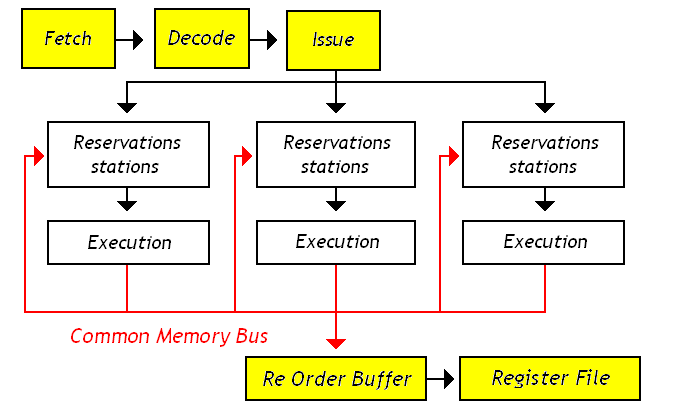
Though the technique of out-of-order CPU execution with Tomasulo’s algorithm had
been designed in the 60’s it did not make its way into popular consumer hardware
until the Pentium Pro in the 1995.
Further Pentium revisions such as the Pentium III, Pentium 4 and Core
architectures are based on this same architecture. Understanding
this architecture is a key to understanding modern CPUs.
In this article we will point out comparisons between the Marocchino and Pentium pro
who’s architecture can be seen in the below diagram.
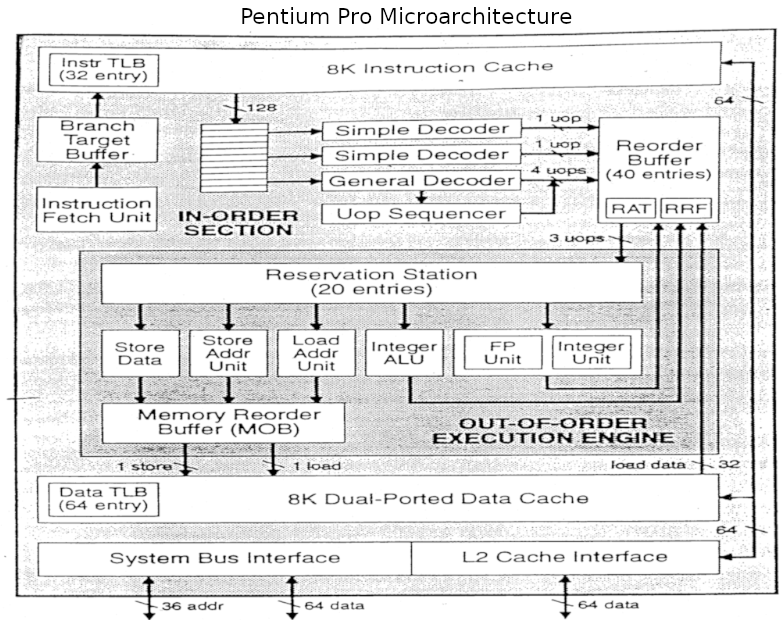
The Marocchino implements the Tomasulo algorithm in a CPU that can be synthesized
and run on an FPGA. Let’s dive into the implementation by breaking down the
building blocks used in Tomasulo’s algorithm and how they have been implemented in
Marocchino.
Tomasulo Building blocks
Besides the basic CPU modules like Instruction Fetch, Decode and Register File,
the building blocks that are used in the Tomasulo algorithm are as follows:
- Reservation Station - A
queue where decoded instructions are placed before they can be
executed. Instructions are placed in the queue with their decoded operation
and available arguments. If any arguments are not available the reservation
station will wait until the arguments are available before executing.
- Execution Units - The execution units include the Arithmetic
Logic Unit (ALU), Memory Load/Store Unit or FPU is responsible for performing
the instruction operation.
- Re-order Buffer (ROB) - A ring
buffer which manages the order in which instructions are retired. In Marocchino
the implementation is slightly simplified and called the Order Control Buffer (OCB).
- Instruction Ids - As an instruction is queued into the ROB, or OCB in Marocchino
it is assigned an Instruction Id which is used to track the instruction in different
components in Marocchino code this is called the
extaddr.
- Register Allocation Table (RAT) - A table used for data hazard resolution.
The RAT table has one cell per OpenRISC general purpose register, 32 entries.
Each RAT cell indicates if a register is busy being produced by a queued
instruction and which instruction will produce it.
- Common Data Bus - Execution units present their result to all reservation stations
along with the register file. Writing to the reservation station provides
immediate resolution of data hazards. The link between execution units,
reservation stations and register file is referred to as the common data bus.
The below diagram shows how these components are arranged in the Marocchino processor.
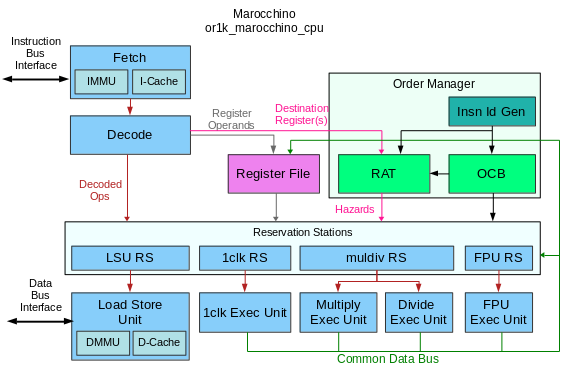
Resolving Data Hazards
As mentioned above the goal of a pipelined architecture is to retire one
instruction per clock cycle.
Pipelining helps achieve
this by splitting an instruction into pipeline stages i.e. Fetch, Decode,
Execute, Load/Store and Register Write Back. If one instruction depends on the
results produced by a previous instruction will be a problem as register
write back of the previous instruction may not complete before registers are
read during the Decode phase of a instruction. This and other types of dependencies
between pipeline stages are called
hazards, and
they must be avoided.
The Tomasulo algorithm with its Reservation Stations, Register Allocation Tables
and other building blocks try to avoid hazards causing pipeline stalls. Let’s look
at a simple example to see how this is done.
- instruction 1 -
b = a * 2
- instruction 2 -
x = a + b
- instruction 3 -
y = x / y
Here we can see that instruction 2 depends on instruction 1 as the addition
of a + b cannot be performed until b is produced by instruction 1.
Let’s assume that instruction 1 is currently executing on the MULTIPLY unit.
The CPU decodes instruction 2, instead of detecting a data hazard and stalling
the pipeline instruction 2 will be placed in the reservation station of the
ADD execution unit. The RAT indicates that b is busy and being produced by
insruction 1. This means instruction 2 cannot execute right away. Next, we
can look at instruction 3 and place it onto the reservation station of the
DIVIDE execution unit. As instruction 3 has no hazards for x and y it
can proceed directly to execution, even before instruction 2 is ready for
execution.
Note, if a required reservation station is full the pipeline will stall.
Register Renaming
As mentioned above, execution units will present their output onto the common
data bus wrbk_result and the data will be written into reservation stations.
Writing the register to the reservation station may occur before writing
back to the register file. This is what register renaming is, as the
register input does not come directly from the register file.
Instruction Id
When an instruction is issued it may be registered in the RAT, OCB and Reservation
Station. It is assigned an Instruction Id for tracking purposes. In Marocchino
this is called the extadr and is 3 bits wide. It is generated by the simple
instruction ID generation logic.
The is implemented in or1k_marocchino_oman.v with the following counter
logic which generates a new extadr every time an instruction is decoded.
// extension to DEST, FLAG or CARRY
// Zero value is reserved as "not used"
localparam [DEST_EXTADR_WIDTH-1:0] EXTADR_MAX = ((1 << DEST_EXTADR_WIDTH) - 1);
localparam [DEST_EXTADR_WIDTH-1:0] EXTADR_MIN = 1;
// ---
reg [DEST_EXTADR_WIDTH-1:0] dcod_extadr_r;
wire [DEST_EXTADR_WIDTH-1:0] extadr_adder;
// ---
assign extadr_adder = (dcod_extadr_r == EXTADR_MAX) ? EXTADR_MIN : (dcod_extadr_r + 1'b1);
// ---
always @(posedge cpu_clk) begin
if (pipeline_flush_i)
dcod_extadr_r <= {DEST_EXTADR_WIDTH{1'b0}};
else if (padv_dcod_i)
dcod_extadr_r <= fetch_valid_i ? extadr_adder : dcod_extadr_r;
end // @clock
// support in-1clk-unit forwarding
assign dcod_extadr_o = dcod_extadr_r;
Every instruction that is queued by the order manager is designated
an extadr. This allows components like the reservation station and RAT tables
to track when an instruction starts and completes executing.
The interactions between the extadr and other components are as follows.
During decode:
- the ID generator generates the
extaddr by incrementing a counter.
- the OCB registers the
extaddr along with other decoded instruction details
- the RAT registers an
extaddr for the decoded instruction to indicate which
instruction will resolve a hazard.
During execution:
- the OCB broadcasts the
extaddr of the oldest instruction registered in a FIFO
fashion. This is to indicate which instruction is to be retired and ensures
instructions are retired in order.
- the RAT outputs the
extaddr indicating which queued instruction will produce a register
- the RAT receives an
extaddr from the OCB output to clear allocation flags
- the Reservation Station receives the
extaddr with hazards to track when
instructions have finished and results are available.
Register Allocation Table
The register allocation table (RAT), sometimes called register alias table, keeps
track of which registers are currently in progress of being generated by pending
instructions. This is used to derive and resolve hazards.
The outputs of the RAT cell are:
rat_rd_extadr_o - indicates which extadr instruction has been allocated to
generate this register.
This will be updated with decod_extadr_i when padv_exec_i goes high.rat_rd_alloc_o - indicates that this register is currently allocated to an
instruction which is not yet complete.
This will be set when padv_exec_i goes high, decod_rfd_we_i is high,
and dcod_rfd_adr_i is equal to GPR_ADR.
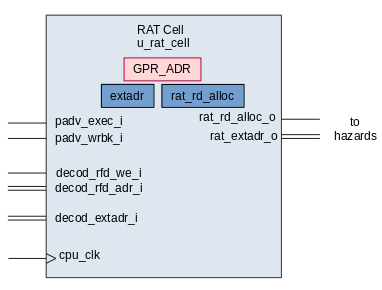
The RAT table is made of 32 rat_cell modules; one cell per register. The
register which the cell is allocated to is stored within GPR_ADR in the rat
cell.
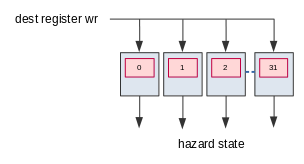
Outputs of the RAT are registered to reservation stations. The hazards are
derived with the following logic in or1k_marocchino_oman.v.
The omn2dec_hazard_d1a1_o hazard means that the argument a of the decoded
instruction will be resolved when the instruction with extadr in omn2dec_extadr_dxa1_o is
retired. The 2 in d2, a2 and b2 represent the 2nd register used in 64-bit
FPU instructions.
// # relative operand A1
assign omn2dec_hazard_d1a1_o = rat_rd1_alloc[dcod_rfa1_adr_i] & dcod_rfa1_req_i;
assign omn2dec_hazard_d2a1_o = rat_rd2_alloc[dcod_rfa1_adr_i] & dcod_rfa1_req_i;
assign omn2dec_extadr_dxa1_o = rat_extadr[dcod_rfa1_adr_i];
// # relative operand B1
assign omn2dec_hazard_d1b1_o = rat_rd1_alloc[dcod_rfb1_adr_i] & dcod_rfb1_req_i;
assign omn2dec_hazard_d2b1_o = rat_rd2_alloc[dcod_rfb1_adr_i] & dcod_rfb1_req_i;
assign omn2dec_extadr_dxb1_o = rat_extadr[dcod_rfb1_adr_i];
// # relative operand A2
assign omn2dec_hazard_d1a2_o = rat_rd1_alloc[dcod_rfa2_adr_i] & dcod_rfa2_req_i;
assign omn2dec_hazard_d2a2_o = rat_rd2_alloc[dcod_rfa2_adr_i] & dcod_rfa2_req_i;
assign omn2dec_extadr_dxa2_o = rat_extadr[dcod_rfa2_adr_i];
// # relative operand B2
assign omn2dec_hazard_d1b2_o = rat_rd1_alloc[dcod_rfb2_adr_i] & dcod_rfb2_req_i;
assign omn2dec_hazard_d2b2_o = rat_rd2_alloc[dcod_rfb2_adr_i] & dcod_rfb2_req_i;
assign omn2dec_extadr_dxb2_o = rat_extadr[dcod_rfb2_adr_i];
Reservation Stations
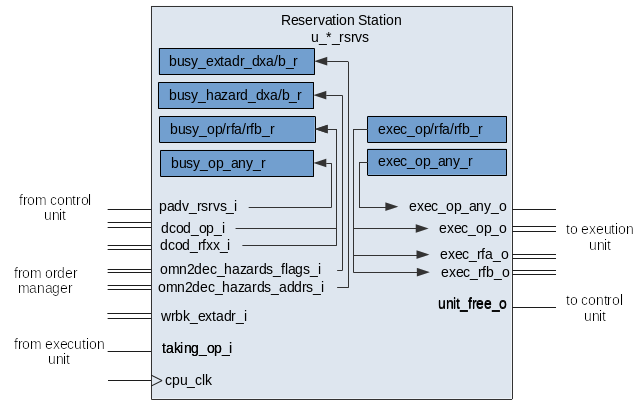
The reservation station receives an instruction from the decode stage and queues
it until all hazards are resolved and the execution unit is free.
Each reservation station has one busy slot and one execution slot. In the
Pentium Pro there were 20 reservation station slots, the Marocchino has 5 or 10
depending if you count the execution slots.
Reservation stations are populated when the pipeline advance padv_rsrvs_i signal comes.
An instruction may be forwarded directly to execution if there are no hazards
and the execution unit is free.
The reservation station resolves hazards by watching and comparing wrbk_extadr_i
with the busy_extadr_dxa_r and busy_extadr_dxb_r registers. If the two match
it means that the instruction producing register A or B has finished writing back
its results and the hazard can be cleared.
Writeback forwarding is handled via the following verilog multiplexer and register logic.
The first bit is used to register the decoded values dcod_rf* from the register
file otherwise we watch for inputs from the forwarding logic. If there is a pending hazard
results are forwarded from the common data bus, otherwise results are maintained.
// BUSY stage operands A1 & B1
always @(posedge cpu_clk) begin
if (padv_rsrvs_i) begin
busy_rfa1_r <= dcod_rfa1;
busy_rfb1_r <= dcod_rfb1;
end
else begin
busy_rfa1_r <= busy_rfa1;
busy_rfb1_r <= busy_rfb1;
end
end // @clock
// Forwarding
// operand A1
assign busy_rfa1 = busy_hazard_d1a1_r ? wrbk_result1_i :
(busy_hazard_d2a1_r ? wrbk_result2_i : busy_rfa1_r);
// operand B1
assign busy_rfb1 = busy_hazard_d1b1_r ? wrbk_result1_i :
(busy_hazard_d2b1_r ? wrbk_result2_i : busy_rfb1_r);
When all hazard flags are cleared the contents of busy_op_r , busy_rfa_r and
busy_rfb_r will be transferred to exec_op_any_r, exec_op_r, etc. They
are presented on the outputs and the execution unit can take them and start processing.
The unit_free_o output signals the control unit that the reservation station
is free and can be issued another instruction. The signal goes high when all hazards
are cleared and the busy state transfers to exec.
Execution Units
In Marocchino the execution units (also referred to as functional units)
execute instructions which it receives from the reservation stations.
The execution units in Marocchino are:
or1k_marocchino_int_1clk - handles integer instructions which can complete
in 1 clock cycle. This includes SHIFT, ADD, AND, OR etc.or1k_marocchino_int_div - handles integer DIVIDE operations.or1k_marocchino_int_mul - handles integer MULTIPLY operations.or1k_marocchino_lsu - handles memory load store operations. It interfaces
with the data cache, MMU and memory bus.pfpu_marocchino_top - handles floating point operations. These include
ADD, MULTIPLY, CMP, I2F etc.
Handshake signals between the reservation station and execution units are used
to issue operations to execution units.
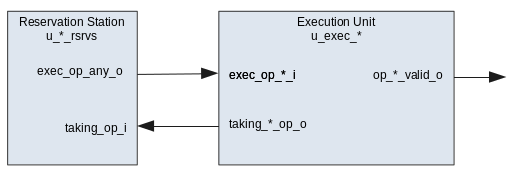
The taking_op_i is the signal from the execution unit signalling it has
received the op and the reservation station will clear all exec_*_o output
signals.
Order Control Buffer
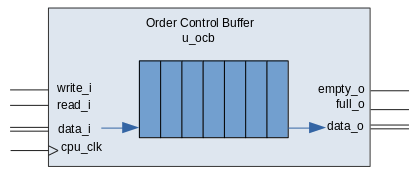
In the Marocchino the Order Control Buffer (OCB) is the in order retirement
unit. It can retire a single instruction at a time. The implementation is a 7
entry FIFO queue. This is much less than the Pentium Pro which contains 40
slots. The OCB receives a single instruction at time from the decoder and
broadcasts the oldest instruction for other components to see. Instructions are
retired after execution write back is complete.
If the OCB output indicates a branch instruction or an exception, branch logic
is invoked. Instead of waiting for write back to a register the write back logic
in the Marocchino will perform the branch operations. This may include flushing
the OCB. Special care is taken to handle branch delay slot instruction execution.
The OCB is different from a traditional Tomasulo Reorder Buffer (ROB) in that it
does not store any execution write back results.
Each OCB entry stores:
- The Instruction ID
extaddr
- The type of instruction
- The register destination addresses used for write back
- Any Fetch and Decode exceptions
This can be seen as defined by the ocbi and ocbi wire buses in
or1k_marocchino_oman.v.
// --- OCB-Controls input ---
wire [OCBT_MSB:0] ocbi;
assign ocbi =
{
// --- pipeline [C]ontrol flags ---
dcod_extadr_r, // OCB-Controls entrance
dcod_op_ls_i, // OCB-Controls entrance
dcod_op_fpxx_cmp_i, // OCB-Controls entrance
dcod_op_fpxx_arith_i, // OCB-Controls entrance
dcod_op_mul_i, // OCB-Controls entrance
dcod_op_div_i, // OCB-Controls entrance
dcod_op_1clk_i, // OCB-Controls entrance
dcod_op_jb_r, // OCB-Controls entrance
dcod_op_push_wrbk_i, // OCB-Controls entrance
// --- instruction [A]ttributes ---
pc_decode_i, // OCB-Attributes entrance
dcod_rfd2_adr_i, // OCB-Attributes entrance
dcod_rfd2_we_i, // OCB-Attributes entrance
dcod_rfd1_adr_i, // OCB-Attributes entrance
dcod_rfd1_we_i, // OCB-Attributes entrance
dcod_delay_slot_i, // OCB-Attributes entrance
dcod_op_rfe_i, // OCB-Attributes entrance
// Flag that istruction is restartable
interrupts_en, // OCB-Attributes entrance
// Combined IFETCH/DECODE an exception flag
dcod_an_except_fd_i, // OCB-Attributes entrance
// FETCH & DECODE exceptions
dcod_fetch_except_ibus_err_r, // OCB-Attributes entrance
dcod_fetch_except_ipagefault_r, // OCB-Attributes entrance
dcod_fetch_except_itlb_miss_r, // OCB-Attributes entrance
dcod_except_illegal_i, // OCB-Attributes entrance
dcod_except_syscall_i, // OCB-Attributes entrance
dcod_except_trap_i // OCB-Attributes entrance
};
// --- INSN OCB input ---
wire [OCBT_MSB:0] ocbo;
Common Data Bus
As discussed above the common data collects write back results from execution units
and routes them for write back.
This can be seen in the or1k_marocchino_cpu.v
as below.
// --- regular ---
always @(wrbk_1clk_result or wrbk_div_result or wrbk_mul_result or
wrbk_fpxx_arith_res_hi or wrbk_lsu_result or wrbk_mfspr_result)
begin
wrbk_result1 = wrbk_1clk_result | wrbk_div_result | wrbk_mul_result |
wrbk_fpxx_arith_res_hi | wrbk_lsu_result | wrbk_mfspr_result;
end
// --- FPU64 extention ---
assign wrbk_result2 = wrbk_fpxx_arith_res_lo;
Conclusion
Tomasulo’s algorithm is still relevant today and used in many processors.
Marocchino provides an accessible implementation. Marocchino is however, not
super-scalar, while Pentium Pro can decode up to 4 instructions at a time the Marocchino
can only decode 1 at a time.
Furthermore many improvements can be made to Marocchino to increase performance. Including:
- Full featured reorder buffer
- Parallel instruction decoding
- Speculative execution; or should we?
- More reservation station slots
However, these come with a cost of size on the FPGA. If you are interested in helping
out please feel free to contribute.
If anything in this article could be improved, more timing diagrams, typos or fixes
for diagrams please send me a message on twitter.
Further Reading and Sources
18 Jul 2019
This is an ongoing series of posts on the Marocchino CPU, an open source out-of-order
OpenRISC cpu. In this series we will review the Marocchino and it’s architecture.
If you haven’t already I suggest you start of by reading the intro in Marocchino in Action.
In the last article, Marocchino in Action we discussed the history of
the CPU and how to setup setup a development environment for it. In this
article let’s look a bit deeper into how the Marocchino CPU works.
We will look at how an instruction flows through the Marocchino pipeline.
Marocchino Architecture
The Marocchino source code is available on
github
and is easy to navigate. We have these directories:
rtl/verilog - the core verilog code, with toplevel modules
or1k_marocchino_top.v - top level module, connects CPU to wishbone busor1k_marocchino_cpu.v - CPU module, connects CPU pipeline
rtl/verilog/pfpu_marocchino - the FPU implementation
pfpu_marocchino_top.v - FPU module, wires together FPU components
bench - test bench harness monitor modulesdoc - design documentation
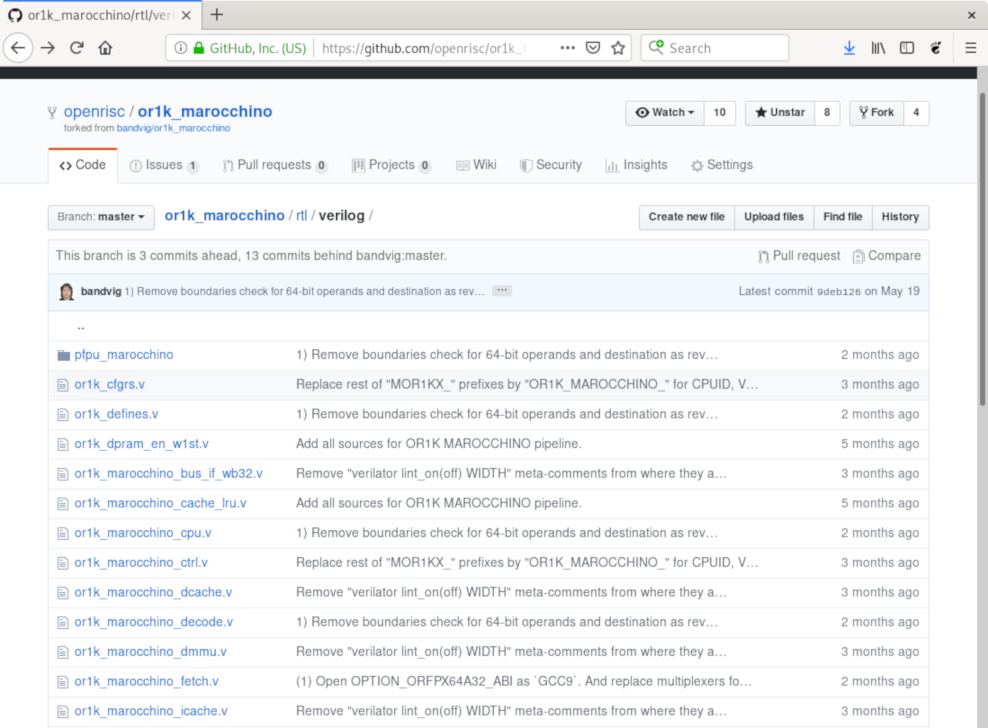
At first glance of the code the Marocchino may look like a traditional 5 stage
RISC pipeline. It has
fetch, decode, execution, load/store and register write back modules which you
might picture in your head as follows:
PIPELINE CRTL - progress/stall the pipeline
(or1k_marocchino_ctrl.v)
INSTRUCTION PIPELINE - process an instruction
|
V
/ FETCH \
\ (or1k_marocchino_fetch.v) /
|
V
/ DECODE \
\ (or1k_marocchino_decode.v) /
|
V
/ EXECUTE \
| (or1k_marocchino_int_1clk.v) ALU |
| (or1k_marocchino_int_div.v) DIVISION |
\ (or1k_marocchino_int_mul.v) MULTIPLICATION /
|
V
/ LOAD STORE \
\ (or1k_marocchino_lsu.v) TO/FROM RAM /
|
V
/ WRITE BACK \
\ (or1k_marocchino_rf.v) /
However, once you look a bit closer you notice some things that are different.
The top-level module
or1k_marocchino_cpu
connects the modules and shows:
- Between the decode and execution units there are reservation stations.
- Along with the control unit, there is an order manager module which provides control signals.
- The load/store execution unit is done as part of the execution stage.
What this CPU is is a super-scalar instruction pipeline with in order instruction
retirement implementing the Tomasulo algorithm.
A simplified view of the CPU’s internal module layout is as per the below diagram.
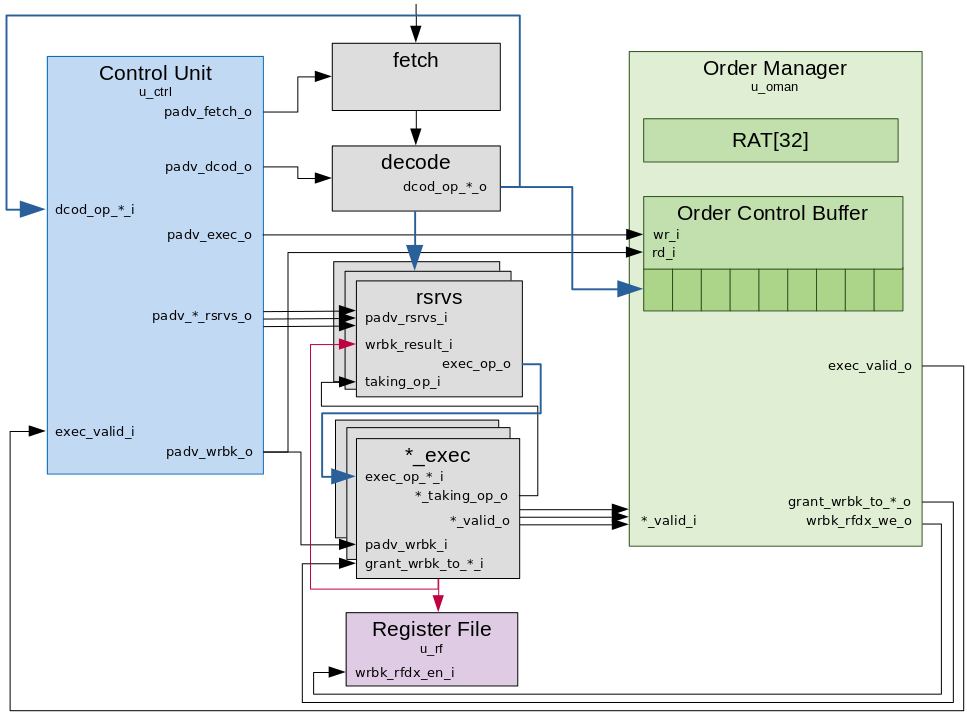
Pipeline Controls
The marocchino has two modules for coordinating pipeline stage instruction propagation. The
control unit and the order manager.
Control Unit
The control unit of the CPU is in charge of watching over the pipeline stages
and signalling when operations can transfer from one stage to the next. The
Marocchino does this with a series of pipeline advance (padv_*) signals. In
general for the best efficiency all padv_* wires should be high at all times
allowing instructions to progress on every clock cycle. But as we will see in
reality, this is difficult to achieve due to pipeline stall scenarios like cache
misses and branch prediction misses. The padv_* signals include:
padv_fetch_o
The padv_fetch_o signal instructs the instruction fetch unit to progress.
Internally the fetch unit has 3 stages. The instruction fetch unit interacts
with the instruction cache and instruction memory management unit (MMU).
The padv_fetch_o signal goes low and the pipeline stalls when the decode
module is busy (dcod_emtpy_i is low). The signal dcod_empty_i comes from
the Decode module and indicates that an instruction can be accepted by the
decode stage.
This is represented by this assign in or1k_marocchino_ctrl.v:
Note The stepping and pstep[] signals are related to debug single stepping, and can be
ignored for our purposes.
// Advance IFETCH
// Stepping condition is close to the one for DECODE
assign padv_fetch_o = padv_all & ((~stepping) | (dcod_empty_i & pstep[0])); // ADV. IFETCH
padv_dcod_o
The padv_dcod_o signal instructs the instruction decode stage to output
decoded operands. The decode unit is one stage, if padv_dcod_o is high, it
will decode the instruction input every cycle.
The padv_dcod_o signal goes low if the destination reservation station for the
operands cannot accept an instruction.
This is represented by this assign in or1k_marocchino_ctrl.v:
// Advance DECODE
assign padv_dcod_o = padv_all & (~wrbk_rfdx_we_i) & // ADV. DECODE
(((~stepping) & dcod_free_i & (dcod_empty_i | ena_dcod)) | // ADV. DECODE
(stepping & dcod_empty_i & pstep[0])); // ADV. DECODE
padv_exec_o and padv_*_rsrvs_o
The padv_exec_o signal to order manager enqueues decoded ops into the Order Control
Buffer (OCB). The OCB is a FIFO
queue which keeps track of the order instructions have been decoded.
The padv_*_rsrvs_o signal wired one of the reservation stations
enables registering of an instruction into a reservation station. There is one
padv_*_rsrvs_o signal and reservation station per execution unit. They are:
padv_1clk_rsrvs_o - to the reservation station for single clock ALU operationspadv_muldiv_rsrvs_o - to the reservation station for multiply and divide
operations. Divide operations take 32 clock cycles. Multiply operations
execute with 2 clock cycles.padv_fpxx_rsrvs_o - to the reservation station for the floating point unit
(FPU). There are multiple FPU operations including multiply, divide, add,
subtract, comparison and conversion between integer and floating point.padv_lsu_rsrvs_o - to the reservation station for the load store unit. The
load store unit will load data from memory
to registers or store data from registers to memory. It interacts with the
data cache and data MMU.
Both padv_exec_o and padv_*_rsrvs_o are dependent on the execution units being
ready and both signals will go high or low at the same time.
This is represented by the assign in or1k_marocchino_ctrl.v:
// Advance EXECUTE (push OCB & clean up DECODE)
assign padv_exec_o = ena_exec & padv_an_exec_unit;
// Per execution unit (or reservation station) advance
assign padv_1clk_rsrvs_o = ena_1clk_rsrvs & padv_an_exec_unit;
assign padv_muldiv_rsrvs_o = ena_muldiv_rsrvs & padv_an_exec_unit;
assign padv_fpxx_rsrvs_o = ena_fpxx_rsrvs & padv_an_exec_unit;
assign padv_lsu_rsrvs_o = ena_lsu_rsrvs & padv_an_exec_unit;
padv_wrbk_o
The padv_wrbk_o signal to the execution units will go active when exec_valid_i is active
and will finalize writing back the execution results. The padv_wrbk_o signal to
the order manager will retire the oldest instruction from the OCB.
This is represented by this assign in or1k_marocchino_ctrl.v:
// Advance Write Back latches
wire exec_valid_l = exec_valid_i | op_mXspr_valid;
assign padv_wrbk_o = exec_valid_l & padv_all & (~wrbk_rfdx_we_i) & ((~stepping) | pstep[2]);
An astute reader would notice that there are no pipeline advance (padv_*)
signals to each of the execution units. This is where the order manager comes
in.
Order Manager
The order manager ensures that instructions are retired in the same order that they are decoded.
It contains a register allocation table (RAT) for hazard resolution and the OCB.
We will go into more depth on the RAT in the next article, but for now let’s look
at how the order manager interacts with the instruction pipeline flow.
exec_valid_o
As the OCB is a FIFO queue the output port presents the oldest non retired
instruction to the order manager. The exec_valid_o signal to the control unit
will go active when the *_valid_i signal from the execution unit and the OCB
output instruction match.
This is represented by this assign in or1k_marocchino_oman.v:
assign exec_valid_o =
(op_1clk_valid_l & ~ocbo[OCBTC_JUMP_OR_BRANCH_POS]) | // EXEC VALID: but wait attributes for l.jal/ljalr
(exec_jb_attr_valid & ocbo[OCBTC_JUMP_OR_BRANCH_POS]) | // EXEC VALID
(div_valid_i & ocbo[OCBTC_OP_DIV_POS]) | // EXEC VALID
(mul_valid_i & ocbo[OCBTC_OP_MUL_POS]) | // EXEC VALID
(fpxx_arith_valid_i & ocbo[OCBTC_OP_FPXX_ARITH_POS]) | // EXEC VALID
(fpxx_cmp_valid_i & ocbo[OCBTC_OP_FPXX_CMP_POS]) | // EXEC VALID
(lsu_valid_i & ocbo[OCBTC_OP_LS_POS]) | // EXEC VALID
ocbo[OCBTC_OP_PUSH_WRBK_POS]; // EXEC VALID
The OCB helps the order manager ensure that instructions are retired in the same
order that they are decoded.
grant_wrbk_*_o
The grant_wrbk_*_o signal to the execution units will go active depending on
the OCB output port instruction.
This is represented by this assign in
or1k_marocchino_oman.v:
// Grant Write-Back-access to units
assign grant_wrbk_to_1clk_o = ocbo[OCBTC_OP_1CLK_POS];
assign grant_wrbk_to_div_o = ocbo[OCBTC_OP_DIV_POS];
assign grant_wrbk_to_mul_o = ocbo[OCBTC_OP_MUL_POS];
assign grant_wrbk_to_fpxx_arith_o = ocbo[OCBTC_OP_FPXX_ARITH_POS];
assign grant_wrbk_to_lsu_o = ocbo[OCBTC_OP_LS_POS];
assign grant_wrbk_to_fpxx_cmp_o = ocbo[OCBTC_OP_FPXX_CMP_POS];
The grant_wrbk_*_o signal along with the padb_wrbk_o signal signal an
execution unit that it can write back its result to the register file / RAT /
reservation station.
wrbk_rfd1_we_o, wrbk_rfd2_we_o and wrbk_rfdx_we_o
The wrbk_rfd1_we_o and wrbk_rfd2_we_o signals enable writeback
to the register file. There are 2 signals because some 64-bit FPU instructions
require writing results to 2 registers. When there is just a single register to write
only signal wrbk_rfd1_we_o is used. When there are two results, writing happens
in 2-stages, first wrbk_rfd1_we_o signals the write back to register 1 then in
the next cycle wrbk_rfd2_we_o signals the write back to register 2.
The wrbk_rfdx_we_o signal to the control unit stalls the pipeline to allow
the second write to complete.
This is represented by this logic in
or1k_marocchino_oman.v:
// instuction requests write-back
wire exec_rfd1_we = ocbo[OCBTA_RFD1_WRBK_POS];
wire exec_rfd2_we = ocbo[OCBTA_RFD2_WRBK_POS];
...
// 1-clock Write-Back-pulses
// # for D1
always @(posedge cpu_clk) begin
if (padv_wrbk_i)
wrbk_rfd1_we_o <= exec_rfd1_we;
else
wrbk_rfd1_we_o <= 1'b0;
end // @clock
// # for D2 we delay WriteBack for 1-clock
// to split write into RF from D1
always @(posedge cpu_clk) begin
if (cpu_rst) begin
wrbk_rfdx_we_o <= 1'b0; // flush
wrbk_rfd2_we_o <= 1'b0; // flush
end
else if (wrbk_rfd2_we_o) begin
wrbk_rfdx_we_o <= 1'b0; // D2 write done
wrbk_rfd2_we_o <= 1'b0; // D2 write done
end
else if (wrbk_rfdx_we_o)
wrbk_rfd2_we_o <= 1'b1; // do D2 write
else if (padv_wrbk_i)
wrbk_rfdx_we_o <= exec_rfd2_we;
end // @clock
The padv_wrbk_i signal from the control unit to the order manager also takes
care of dequeuing the last instruction from the OCB. With that and the
writebacks completed the instruction is said to be retired.
Conclusion
The Marocchino instruction pipeline is not very complicated while still being
full featured including Caches, MMU and FPU. We have mentioned
a few structures such as Reservation Station and RAT which we haven’t gone into
much details on. These help implement out-of-order superscalar execution using
Tomasulo’s algorithm. In the next article we will go into more details on these
components and how Tomasulo works.
11 Jun 2019
Update 2021: There are a few fusesoc command's below. They have been updated
to work with the latest fusesoc and core versions.
The Marocchino is an advanced new OpenRISC soft core CPU. However, not many
have heard about it. Let’s try to change this.
In this series of posts I would like to take the reader over some key parts
of the Marocchino and it’s architecture.
- Marocchino in Action - (this article) A light intro and a guide to getting started with Marocchino
- Instruction Pipeline - An deep dive into how the Marocchino pipeline is structured
- A Tomasulo Implementation - How the Marocchino achieves Out-of-Order execution
Introducing Marocchino
In the beginning of 2019 I had finished the OpenRISC GCC port
and was working on building up toolchain test and verification support using the
mor1kx soft core. Part of the mor1kx’s
feature set is the ability to swap out different pipeline arrangements to
configure the CPU for performance or resource usage. Each pipeline is named
after an Italian coffee, we have Cappuccino, Espresso and Pronto-Espresso. One
of these pipelines which has been under development but never integrated into
the main branch was the Marocchino. I had never paid much attention to the
Marocchino pipeline.
Around the same time the author of Marocchino sent a mail mentioning he could
not use the new GCC port as it was missing Single and Double precision FPU
support. Using the new verification pipeline I set out to start working on
adding single and double precision floating point support to the OpenRISC gcc
port. My verification target would be the Marocchino pipeline.
After some initial investigation I found this CPU was much more than a new pipeline
for the mor1kx with a special FPU. The marocchino has morphed into a complete re-implementation
of the OpenRISC 1000 spec. Seeing this we split
the marocchino out to it’s own repository
where it could grow on it’s own. Of course maintaining the Italian coffee name.
With features like out-of-order execution using
Tomasulo’s algorithm, 64-bit
FPU operations using register pairs, MMU, Instruction caches, Data caches,
Multicore support and a clean verilog code base the Marocchino is advanced to
say the least.
I would claim Marocchino is one of the most advanced implementations of a
out-of-order execution open source CPU cores. One of it’s friendly rivals is the
BOOM core a 64-bit risc-v
implementation written in Chisel. To contrast Marocchino has a similar feature
set but is 32-bit OpenRISC written in verilog making it approachable. If you
know more out-of-order execution open source cores I would love to know, and I
can update this list.
Let’s dive in.
Getting started with Marocchino
We can quickly get started with Marocchino as we use
FuseSoC. Which makes bringing together an
running verilog libraries, or cores, a snap.
Environment Setup
The Marocchino development environment requires Linux, you can use a VM, docker
or your own machine. I personally use fedora and maintain several Debian docker
images for continuous integration and package builds.
The environment we install allows for simulating verilog using
icarus or
verilator. It also allows synthesis
and programming to an FPGA using EDA tools. Here we will cover only simulation.
For details on programming an SoC to an FPGA using FuseSoC see the build and
pgm commands in FuseSoC documentation.
Note Below we use /tmp/openrisc to install software and work on code, but
you can use any path you like.
Setting up FuseSoC

To get started let’s setup FuseSoC and install the required cores into the
FuseSoC library.
Here we clone the git repositories used for Marocchino development into
/tmp/openrisc/src feel free to have a look, If you feel adventurous make some
changes. The repos include:
- mor1kx-generic - the SoC
system configuration which wires together the CPU, Memory, System bus, UART
and a simple interrupt peripheral.
- or1k_marocchino - the
Marocchino CPU core.
sudo pip install fusesoc
mkdir -p /tmp/openrisc/src
cd /tmp/openrisc/src
git clone https://github.com/stffrdhrn/mor1kx-generic.git
git clone https://github.com/openrisc/or1k_marocchino.git
# As yourself
fusesoc init -y
fusesoc library add intgen https://github.com/stffrdhrn/intgen.git
fusesoc library add elf-loader https://github.com/fusesoc/elf-loader.git
fusesoc library add mor1kx-generic /tmp/openrisc/src/mor1kx-generic
fusesoc library add or1k_marocchino /tmp/openrisc/src/or1k_marocchino
Setting up Icarus Verilog
Next we will need to install our verilog compiler/simulator Icarus Verilog (iverilog).
mkdir -p /tmp/openrisc/iverilog
cd /tmp/openrisc/iverilog
git clone https://github.com/steveicarus/iverilog.git .
sh autoconf.sh
./configure --prefix=/tmp/openrisc/local
make
make install
export PATH=/tmp/openrisc/local/bin:$PATH
Using Docker
Update 2021: The docker images are out of date and no longer work well, please use the manual
setup method.
If you want to get started very quickly faster we can use the
librecores-ci
docker image. Which includes iverilog, verilator and fusesoc.
This allows us to skip the Setting up Icarus Verilog and part of the Setting
up FuseSoC step above.
This can be done with the following.
docker pull librecores/librecores-ci
docker run -it --rm docker.io/librecores/librecores-ci
Setting up GCC
Next we install the GCC toolchain which is used for compiling C and OpenRISC
assembly programs. The produced elf binaries can be loaded and run on the CPU core.
Pull the latest toolchain from my gcc
releases page. Here we use the
newlib (baremetal) toolchain which allows
compiling programs which run directly on the processor. For details on other
toolchains available see the toolchain summary
on the OpenRISC homepage.
mkdir -p /tmp/openrisc
cd /tmp/openrisc
wget https://github.com/stffrdhrn/gcc/releases/download/or1k-9.1.1-20190507/or1k-elf-9.1.1-20190507.tar.xz
tar -xf or1k-elf-9.1.1-20190507.tar.xz
export PATH=/tmp/openrisc/or1k-elf/bin:$PATH
The development environment should now be set up.
To check everything works you should be able to run the following commands.
Setup Verification
To ensure the toolchain is installed and working we can run the following:
$ or1k-elf-gcc --version
or1k-elf-gcc (GCC) 9.1.1 20190503
Copyright (C) 2019 Free Software Foundation, Inc.
This is free software; see the source for copying conditions. There is NO
warranty; not even for MERCHANTABILITY or FITNESS FOR A PARTICULAR PURPOSE.
To ensure FuseSoC and the required cores are installed we can run this:
$ fusesoc core-info mor1kx-generic
CORE INFO
Name: ::mor1kx-generic:1.1
Core root: /root/.local/share/fusesoc/mor1kx-generic
Targets:
marocchino_tb
mor1kx_tb
$ fusesoc list-cores
...
::intgen:0 : local
::or1k_marocchino:5.0-r3 : local
...
Running an Assembly Program
The most simple program you can run on OpenRISC is a simple assembly program.
When running, everything in the below program is loaded into the OpenRISC
memory, nothing more nothing less.
To compile, run and trace a simple assembly program we do the following.
Create a source file asm-openrisc.s as follows:
/* Exception vectors section. */
.section .vectors, "ax"
/* 0x100: OpenRISC RESET reset vector. */
.org 0x100
/* Jump to program initialisation code */
.global _main
l.movhi r4, hi(_main)
l.ori r4, r4, lo(_main)
l.jr r4
l.nop
/* Main executable section. */
.section .text
.global _main
_main:
l.addi r1,r0,0x1
l.addi r2,r1,0x2
l.addi r3,r2,0x4
l.addi r4,r3,0x8
l.addi r5,r4,0x10
l.addi r6,r5,0x20
l.addi r7,r6,0x40
l.addi r8,r7,0x80
l.addi r9,r8,0x100
l.addi r10,r9,0x200
l.addi r11,r10,0x400
l.addi r12,r11,0x800
l.addi r13,r12,0x1000
l.addi r14,r13,0x2000
l.addi r15,r14,0x4000
l.addi r16,r15,0x8000
l.sub r31,r0,r1
l.sub r30,r31,r2
l.sub r29,r30,r3
l.sub r28,r29,r4
l.sub r27,r28,r5
l.sub r26,r27,r6
l.sub r25,r26,r7
l.sub r24,r25,r8
l.sub r23,r24,r9
l.sub r22,r23,r10
l.sub r21,r22,r11
l.sub r20,r21,r12
l.sub r19,r20,r13
l.sub r18,r19,r14
l.sub r17,r18,r15
l.sub r16,r17,r16
/* Set sim return code to 0 - meaning OK. */
l.movhi r3, 0x0
l.nop 0x1 /* Exit simulation */
l.nop
l.nop
To compile this we use or1k-elf-gcc. Note the -nostartfiles option, this is
useful for compiling assembly when we don’t need
newlib/libgloss
provided “startup” sections linked into the binary as we provide them ourselves.
mkdir /tmp/openrisc/src
cd /tmp/openrisc/src
vim openrisc-asm.s
or1k-elf-gcc -nostartfiles openrisc-asm.s -o openrisc-asm
Finally, to run the program on the Marocchino we run fusesoc with the below
options.
run - specifies that we want to run a simulation.--target - is a FuseSoC option for run specifying which of the
mor1kx-generic targets we want to run, here we specify marochino_tb, the
Marocchino test bench.--tool - is a sub option for --target specifying that we want to run the
marocchino_tb target using icarus.::mor1kx-generic:1.1 - specifies which system we want to run. System’s
represent an SoC that can be simulated or synthesized. You can see a list of
system using list-cores.--elf_load - is mor1kx-generic specific option which specifies an elf
binary that will be loaded into memory before the simulation starts.--trace_enable - is a mor1kx-generic specific option enabling tracing.
When specified the simulator will output a trace file to {fusesoc-builds}/mor1kx-generic_1.1/marocchino_tb-icarus/marocchino-trace.log see log.--trace_to_screen - is a mor1kx-generic specific option enabling tracing
instruction execution to the console as we can see below.--vcd - is a mor1kx-generic option instruction icarus to output a vcd
file which creates a trace file which can be loaded with gtkwave.
fusesoc run --target marocchino_tb --tool icarus ::mor1kx-generic:1.1 \
--elf_load ./openrisc-asm --trace_enable --trace_to_screen --vcd
VCD info: dumpfile testlog.vcd opened for output.
Program header 0: addr 0x00000000, size 0x000001A0
elf-loader: /tmp/openrisc/src/openrisc-asm was loaded
Loading 104 words
0 : Illegal Wishbone B3 cycle type (xxx)
S 00000100: 18800000 l.movhi r4,0x0000 r4 = 00000000 flag: 0
S 00000104: a8840110 l.ori r4,r4,0x0110 r4 = 00000110 flag: 0
S 00000108: 44002000 l.jr r4 flag: 0
S 0000010c: 15000000 l.nop 0x0000 flag: 0
S 00000110: 9c200001 l.addi r1,r0,0x0001 r1 = 00000001 flag: 0
S 00000114: 9c410002 l.addi r2,r1,0x0002 r2 = 00000003 flag: 0
S 00000118: 9c620004 l.addi r3,r2,0x0004 r3 = 00000007 flag: 0
S 0000011c: 9c830008 l.addi r4,r3,0x0008 r4 = 0000000f flag: 0
S 00000120: 9ca40010 l.addi r5,r4,0x0010 r5 = 0000001f flag: 0
S 00000124: 9cc50020 l.addi r6,r5,0x0020 r6 = 0000003f flag: 0
S 00000128: 9ce60040 l.addi r7,r6,0x0040 r7 = 0000007f flag: 0
S 0000012c: 9d070080 l.addi r8,r7,0x0080 r8 = 000000ff flag: 0
S 00000130: 9d280100 l.addi r9,r8,0x0100 r9 = 000001ff flag: 0
S 00000134: 9d490200 l.addi r10,r9,0x0200 r10 = 000003ff flag: 0
S 00000138: 9d6a0400 l.addi r11,r10,0x0400 r11 = 000007ff flag: 0
S 0000013c: 9d8b0800 l.addi r12,r11,0x0800 r12 = 00000fff flag: 0
S 00000140: 9dac1000 l.addi r13,r12,0x1000 r13 = 00001fff flag: 0
S 00000144: 9dcd2000 l.addi r14,r13,0x2000 r14 = 00003fff flag: 0
S 00000148: 9dee4000 l.addi r15,r14,0x4000 r15 = 00007fff flag: 0
S 0000014c: 9e0f8000 l.addi r16,r15,0x8000 r16 = ffffffff flag: 0
S 00000150: e3e00802 l.sub r31,r0,r1 r31 = ffffffff flag: 0
S 00000154: e3df1002 l.sub r30,r31,r2 r30 = fffffffc flag: 0
S 00000158: e3be1802 l.sub r29,r30,r3 r29 = fffffff5 flag: 0
S 0000015c: e39d2002 l.sub r28,r29,r4 r28 = ffffffe6 flag: 0
S 00000160: e37c2802 l.sub r27,r28,r5 r27 = ffffffc7 flag: 0
S 00000164: e35b3002 l.sub r26,r27,r6 r26 = ffffff88 flag: 0
S 00000168: e33a3802 l.sub r25,r26,r7 r25 = ffffff09 flag: 0
S 0000016c: e3194002 l.sub r24,r25,r8 r24 = fffffe0a flag: 0
S 00000170: e2f84802 l.sub r23,r24,r9 r23 = fffffc0b flag: 0
S 00000174: e2d75002 l.sub r22,r23,r10 r22 = fffff80c flag: 0
S 00000178: e2b65802 l.sub r21,r22,r11 r21 = fffff00d flag: 0
S 0000017c: e2956002 l.sub r20,r21,r12 r20 = ffffe00e flag: 0
S 00000180: e2746802 l.sub r19,r20,r13 r19 = ffffc00f flag: 0
S 00000184: e2537002 l.sub r18,r19,r14 r18 = ffff8010 flag: 0
S 00000188: e2327802 l.sub r17,r18,r15 r17 = ffff0011 flag: 0
S 0000018c: e2118002 l.sub r16,r17,r16 r16 = ffff0012 flag: 0
S 00000190: 18600000 l.movhi r3,0x0000 r3 = 00000000 flag: 0
S 00000194: 15000001 l.nop 0x0001 flag: 0
exit(0x00000000);
If we look at the VCD trace file in gtkwave we
can see the below trace. The trace file is also helpful for navigating through
the various SoC components as it captures all wire transitions.
Take note that we are not seeing very good performance, this is because caching is
not enabled and the CPU takes several cycles to read an instruction from memory.
This means we are not seeing one instruction executed per cycle. Enabling
caches would fix this.
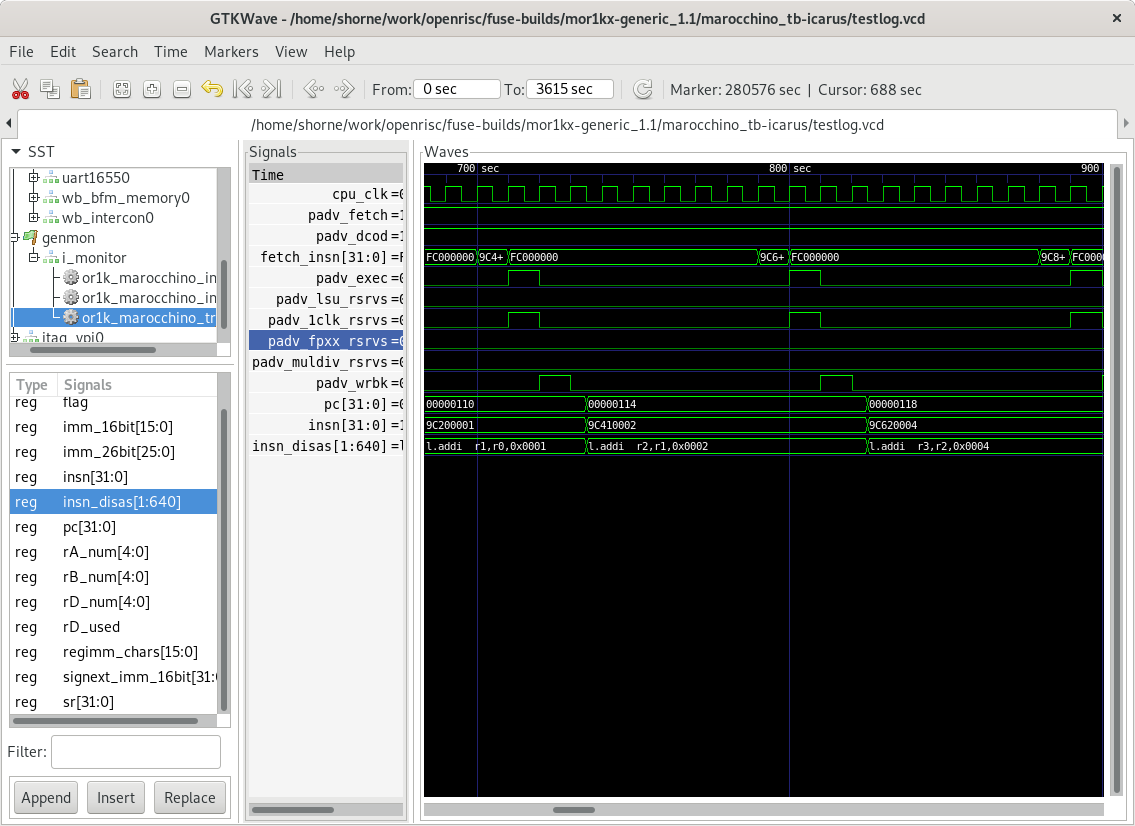
Running a C program
When we compile a C program there is a lot more happening behind the scenes.
The linker will link in an entire runtime that along with standard libc
functions on OpenRISC will setup interrupt vectors, enable caches, setup memory
sections for variables, run static initializers and finally run our program.
The program:
/* Simple c program, doing some math. */
#include <stdio.h>
int a [] = { 1, 2, 3, 4, 5 };
int madd(int a, int b, int c) {
return a * b + c;
}
int main() {
int res;
for (int i = 0; i < 5; i++) {
res = madd(0 , a[1], a[i]);
res = madd(res, a[2], a[i]);
res = madd(res, a[2], a[i]);
res = madd(res, a[3], a[i]);
res = madd(res, a[4], a[i]);
}
printf("Result is = %d\n", res);
return 0;
}
To compile we use the below or1k-elf-gcc command. Notice, we do not specify
-nostartfiles here as we do want newlib to link in all the start routines to
provide a full c runtime. We do specify the following arguments to tell GCC a
bit about our OpenRISC cpu. If these -m options are not specified GCC will
link in code using the libgcc library to emulate these instructions.
-mhard-mul - indicates that our cpu target supports multiply instructions.-mhard-div - indicates that our cpu target supports divide instructions.-mhard-float - indicates that our cpu target supports FPU instructions.-mdouble-float - indicates that our cpu target supports the new double precision floating point instructions using register pairs (orfpx64a32).
To see a full list of options for OpenRISC read the GCC manual or see the output
of or1k-elf-gcc --target-help.
or1k-elf-gcc -Wall -O2 -mhard-mul -mhard-div -mhard-float -mdouble-float -mror \
openrisc-c.c -o openrisc-c
If we want to inspect the assembly to ensure we did generate multiply instructions
we can use the trusty objdump utility. As per below, yes, we can see multiply
instructions.
or1k-elf-objdump -d openrisc-c | grep -A10 main
00002000 <main>:
2000: 1a a0 00 01 l.movhi r21,0x1
2004: 9c 21 ff f8 l.addi r1,r1,-8
2008: 9e b5 40 3c l.addi r21,r21,16444
200c: 86 75 00 10 l.lwz r19,16(r21)
2010: 86 f5 00 08 l.lwz r23,8(r21)
2014: e2 37 9b 06 l.mul r17,r23,r19
2018: e2 31 98 00 l.add r17,r17,r19
201c: e2 31 bb 06 l.mul r17,r17,r23
2020: e2 31 98 00 l.add r17,r17,r19
2024: 86 b5 00 0c l.lwz r21,12(r21)
...
Similar to running the assembly example we can run this with fusesoc as follows.
fusesoc run --target marocchino_tb --tool icarus ::mor1kx-generic:1.1 \
--elf_load ./openrisc-c --trace_enable --vcd
...
Result is = 1330
Now, if we look at the VCD trace file we can see the
below trace. Notice that with the c program we can observe better pipelining where
an instruction can be executed every clock cycle. This is because caches have
been initialized as part of the newlib c-runtime initialization, great!
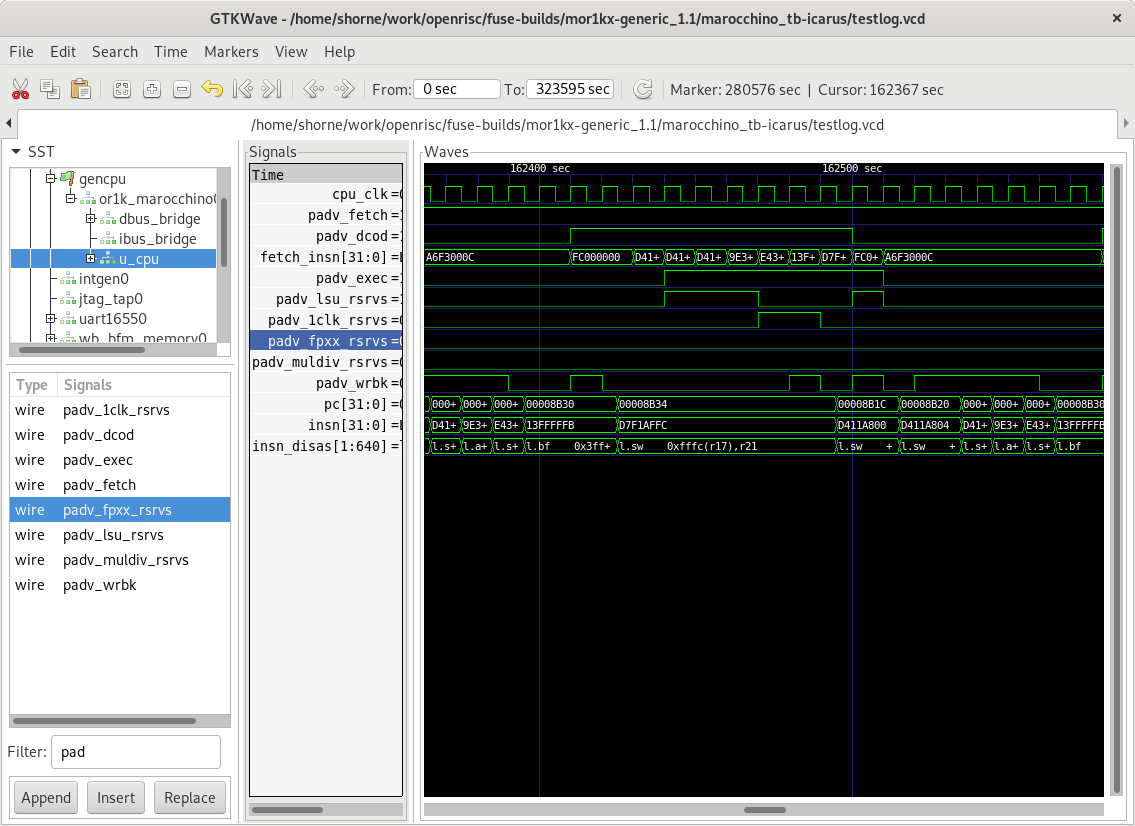
Conclusion
In this article we went through a quick introduction to the Marocchino
development environment. The development environment would actually be similar
when developing any OpenRISC core.
This environment will allow the reader to following in future Marocchino
articles where we go deeper into the architecture. In this environment you can
now:
- Develop and test verilog code for the Marocchino processor
- Develop assembly programs and test them on the Marocchino or other OpenRISC processors
- Develop c programs and test them on the Marocchino or other OpenRISC processors
In the next article we will look more into how the above programs actually flow
through the Marocchino pipeline. Stay tuned.

























